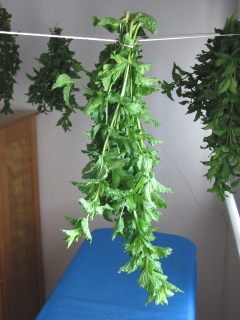Sometimes I think we American cooks get too caught up in what’s fashionable to prepare rather than focusing on what’s divine to eat. Consider peches cardinal. Sort of like Peach Melba without the ice cream, peches cardinal combines two divine fruits—ripe peaches and raspberries—prepared to underscore their savor and highlighted with a touch of vanilla and sugar.
The thought of peches cardinal, in one of those too-rare taste memories, burst into my head this week when I found myself in possession of local raspberries and tree-ripened peaches. I had to have the dish again.
Now, it’s been ages since I made peches cardinal, but I can vividly recall the exhilaration of tasting the dish the first time. The sauce (of pureed, seeded and sweetened berries) screamed raspberry, and the cardinal color truly was brilliant next to the tender, vanilla-tinged poached peach flesh. Ah. Heaven.
This week, though, I had only myself to cook for, and I wanted that dessert ASAP, never mind the chilling and all that. So I created Almost peches cardinal. (I do wish some French scholar would explain to me why there’s no “s” on the end of “cardinal,” but that’s neither here nor there.)
Almost peches cardinal (1 serving)
- 1 large or 2 small ripe peaches
- 2 tablespoons sugar, divided
- 1/8 teaspoon vanilla extract
- 3/4 cup raspberries
- Mint leaves for garnish (optional)
- Slice peach(es) in bowl and sprinkle with 1 tablespoon sugar and the vanilla. Stir to combine.

- Place raspberries and 1 tablespoon sugar in chinois or sieve. Press through to puree berries and dissolve the sugar.

- Pour raspberry sauce over peaches. Garnish with mint if desired. Admire the beauty. Dig in.

Mine was delicious, although not quite to the standard of the memory for two main reasons. First, I jumped the gun; the peaches needed a day on the counter to soften up. Second, the chinois allowed seeds through, mostly because I was determined not to leave any flesh behind. (I shouldn’t have tried so hard, because I wound up scraping the seeds and whatnot off the pestle and ate that, too.) Next time, I may use the chinois and then put the results through a sieve.
If you aren’t in a hurry, though, I heartily recommend the original recipe, from Mastering the Art of French Cooking![]() , Volume 1. (The link goes to the 40th anniversary edition. I have the 1983 edition, well-used. I should note I’ve had a gas stove for about 20 years.) I just may have to acquire more berries and fruit and do it properly.
, Volume 1. (The link goes to the 40th anniversary edition. I have the 1983 edition, well-used. I should note I’ve had a gas stove for about 20 years.) I just may have to acquire more berries and fruit and do it properly.
Peches Cardinal: Poached peaches with raspberry puree (10 servings)
- 6 cups water
- 2 1/4 cups granulated sugar
- 2 tablespoons vanilla extract or 1 vanilla bean
- 12-inch saucepan
Simmer the water, sugar and vanilla extract or bean in the saucepan and stir until sugar has dissolved.
- 10 firm, ripe, unblemished, fresh peaches about 2 1/2 inches in diameter
- A slotted spoon
- A cake rack
- A serving dish 2 inches deep
Add the unpeeled peaches to the simmering syrup. Bring again to the simmer, then maintain at just below the simmer for 8 minutes. Remove pan from heat and let peaches cool in syrup for 20 minutes. (Syrup may be used again for poaching other fruits.) Drain peaches on rack; peel while still warm, and arrange in serving dish. Chill.
- 1 quart fresh raspberries and 1 1/4 cups granulated sugar OR
- 1 1/2 lbs. frozen raspberries, thawed and well drained, and 2/3 cup sugar
- An electric blender (or electric beater)
Force the raspberries through a sieve and place the puree in the jar of an electric blender along with the sugar. Cover and blend at top speed for 2 to 3 minutes, or until puree is thick and sugar has dissolved completely. Chill. (Or beat puree and sugar about 10 minutes with an electric beater.)
- Optional: fresh mint leaves for garnish
When both puree and peaches are chilled, pour the puree over the peaches and return to refrigerator until serving time. Decorate with optional fresh mint leaves.
















